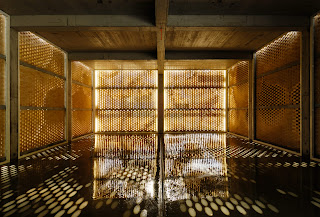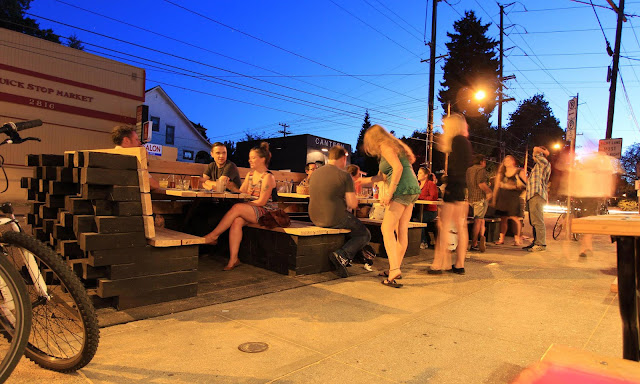Webcasting to a Global Classroom
“The 2010 Imperative Global Emergency Teach-In” may influence education as much as the Climate Crisis
by Lucas Gray
Traditional education has revolved around a group of people gathered together in a single place to listen to a respected elder talk about their expertise. Whether it be an aboriginal tribe chief sharing traditions and heritage through fables, or an esteemed university professor lecturing about Post-modern American literature, for thousands of years this has been the model humans have used to disseminate information. Architecture has played a fundamental role in this traditional educational model. In today’s world buildings are the places of meeting and interacting at our educational institutions. Where once this was an advantage - bringing great minds and diversity together - it has become a limiting factor given our acclimation to worldwide communication with new technology.
Internet has revolutionized the way we access information and communicate with others. Technology is still being tested and adapted to best serve our educational institutions. Professors have slowly started using digital media in the classroom but not in such a way as to match the pace of technological advance. Administrators still question and struggle with how best to utilize and invest in new technology. However, as it slowly becomes more prevalent throughout the educational system the Internet and webcasts can reinvigorate what has become dry and dated.
A couple of years ago I was lucky enough to be studying for my Master of Architecture degree at the University of Oregon when a group of architects, environmentalists and designers concerned with Climate Change held a unique event called The 2010 Imperative Global Emergency Teach-In. Over a quarter of a million people from 47 different countries gathered together on February 20th 2007 to participate in this revolutionary educational event - an interactive webcast where Climate Crisis and Design experts addressed an audience spread throughout world. The event preached the urgency of action and offered strategies to accomplish the goals needed to curb carbon emissions. To see a list of participants click here.
At the University of Oregon School of Architecture, students were huddled around televisions in the corridors, crowded into lecture rooms, stared at laptops at their desks and made impromptu lecture halls with projectors in stairwells. Video cameras were set up for students to ask questions to the speakers and interact with other participants around the world. It became an environment that encouraged dialogue between students and professors, students and their peers, professors and each other, and really tore down the walls of the traditional educational model. No longer was there a single solemn professor standing in front of, and talking at a group of half-asleep students. No longer was it even necessary for students to be in the same room. Instead it became a worldwide conversation - a sharing of ideas. Most importantly, it enabled anyone and everyone who is interested in the topic to tune in. It offered free information to everyone who was willing to listen and learn.
One of the unique aspects of this model of education is the interactive capability it provides. Competitions, workshops, and games were introduced at the 2010 Imperative event, which called for students to make short films, art projects, or essays to post on the website. This allowed the content and the message of the event to spread even more, incorporating the ideas of the thousands of participants. No longer was I learning the knowledge of one individual and his/her point of view but rather I had access to the thoughts, ideas and experiences of people from varying backgrounds, cultures, and climates. New points of view were brought up that our school might not have addressed due to its geographic location or socio economic condition.
When an event allows individual participants to add their input, there tends to be a breakdown in the review process to verify facts within each contribution. A professor has been hired because of his educational background and research work. Hopefully this qualifies him or her to teach their subject matter. This is not the case with user-generated content in a web cast situation. This particular event focused on a series of lectures by experts in the field and then allowed for questions and comments directed to those lecturers. In this particular scenario the additional content was secondary in importance to the primary speakers, which allowed for the well-researched message to come to the forefront. However, this may not always be the case with other Internet based platforms. Web casting may democratize information and education but may also dilute important messages with uninformed opinions.
This event opened my eyes to a new way of education; offering focused events and letting all interested people participate in an interactive way. No longer will education be reserved for those who can afford it. Coupled with the One Laptop Per Child initiative, education and information can be made readily available to all. The advantage lies in the fact that the knowledge available will also have all of humanity contributing to it. The information will evolve and grow to account for differing viewpoints and experience. It will allow students in Oregon to learn about environmental issues in Nepal and ask questions to and collaborate with students living and studying there. The opportunities are endless and outweigh the possible pitfalls of using the web to educate.
The 2010 Imperative Global Emergency Teach-In was a spectacular event that has grown into a movement to create change in the world. It was focused on influencing people to change their habits, lifestyles, and building practices to address the growing concern of Climate Change. However, it may also have revolutionized the way information is disseminated to people throughout the world – how technology can forever change humanity’s educational model and perhaps the architecture of our educational institutions.
by Lucas Gray
Traditional education has revolved around a group of people gathered together in a single place to listen to a respected elder talk about their expertise. Whether it be an aboriginal tribe chief sharing traditions and heritage through fables, or an esteemed university professor lecturing about Post-modern American literature, for thousands of years this has been the model humans have used to disseminate information. Architecture has played a fundamental role in this traditional educational model. In today’s world buildings are the places of meeting and interacting at our educational institutions. Where once this was an advantage - bringing great minds and diversity together - it has become a limiting factor given our acclimation to worldwide communication with new technology.
Internet has revolutionized the way we access information and communicate with others. Technology is still being tested and adapted to best serve our educational institutions. Professors have slowly started using digital media in the classroom but not in such a way as to match the pace of technological advance. Administrators still question and struggle with how best to utilize and invest in new technology. However, as it slowly becomes more prevalent throughout the educational system the Internet and webcasts can reinvigorate what has become dry and dated.
A couple of years ago I was lucky enough to be studying for my Master of Architecture degree at the University of Oregon when a group of architects, environmentalists and designers concerned with Climate Change held a unique event called The 2010 Imperative Global Emergency Teach-In. Over a quarter of a million people from 47 different countries gathered together on February 20th 2007 to participate in this revolutionary educational event - an interactive webcast where Climate Crisis and Design experts addressed an audience spread throughout world. The event preached the urgency of action and offered strategies to accomplish the goals needed to curb carbon emissions. To see a list of participants click here.
At the University of Oregon School of Architecture, students were huddled around televisions in the corridors, crowded into lecture rooms, stared at laptops at their desks and made impromptu lecture halls with projectors in stairwells. Video cameras were set up for students to ask questions to the speakers and interact with other participants around the world. It became an environment that encouraged dialogue between students and professors, students and their peers, professors and each other, and really tore down the walls of the traditional educational model. No longer was there a single solemn professor standing in front of, and talking at a group of half-asleep students. No longer was it even necessary for students to be in the same room. Instead it became a worldwide conversation - a sharing of ideas. Most importantly, it enabled anyone and everyone who is interested in the topic to tune in. It offered free information to everyone who was willing to listen and learn.
One of the unique aspects of this model of education is the interactive capability it provides. Competitions, workshops, and games were introduced at the 2010 Imperative event, which called for students to make short films, art projects, or essays to post on the website. This allowed the content and the message of the event to spread even more, incorporating the ideas of the thousands of participants. No longer was I learning the knowledge of one individual and his/her point of view but rather I had access to the thoughts, ideas and experiences of people from varying backgrounds, cultures, and climates. New points of view were brought up that our school might not have addressed due to its geographic location or socio economic condition.
When an event allows individual participants to add their input, there tends to be a breakdown in the review process to verify facts within each contribution. A professor has been hired because of his educational background and research work. Hopefully this qualifies him or her to teach their subject matter. This is not the case with user-generated content in a web cast situation. This particular event focused on a series of lectures by experts in the field and then allowed for questions and comments directed to those lecturers. In this particular scenario the additional content was secondary in importance to the primary speakers, which allowed for the well-researched message to come to the forefront. However, this may not always be the case with other Internet based platforms. Web casting may democratize information and education but may also dilute important messages with uninformed opinions.
This event opened my eyes to a new way of education; offering focused events and letting all interested people participate in an interactive way. No longer will education be reserved for those who can afford it. Coupled with the One Laptop Per Child initiative, education and information can be made readily available to all. The advantage lies in the fact that the knowledge available will also have all of humanity contributing to it. The information will evolve and grow to account for differing viewpoints and experience. It will allow students in Oregon to learn about environmental issues in Nepal and ask questions to and collaborate with students living and studying there. The opportunities are endless and outweigh the possible pitfalls of using the web to educate.
The 2010 Imperative Global Emergency Teach-In was a spectacular event that has grown into a movement to create change in the world. It was focused on influencing people to change their habits, lifestyles, and building practices to address the growing concern of Climate Change. However, it may also have revolutionized the way information is disseminated to people throughout the world – how technology can forever change humanity’s educational model and perhaps the architecture of our educational institutions.







